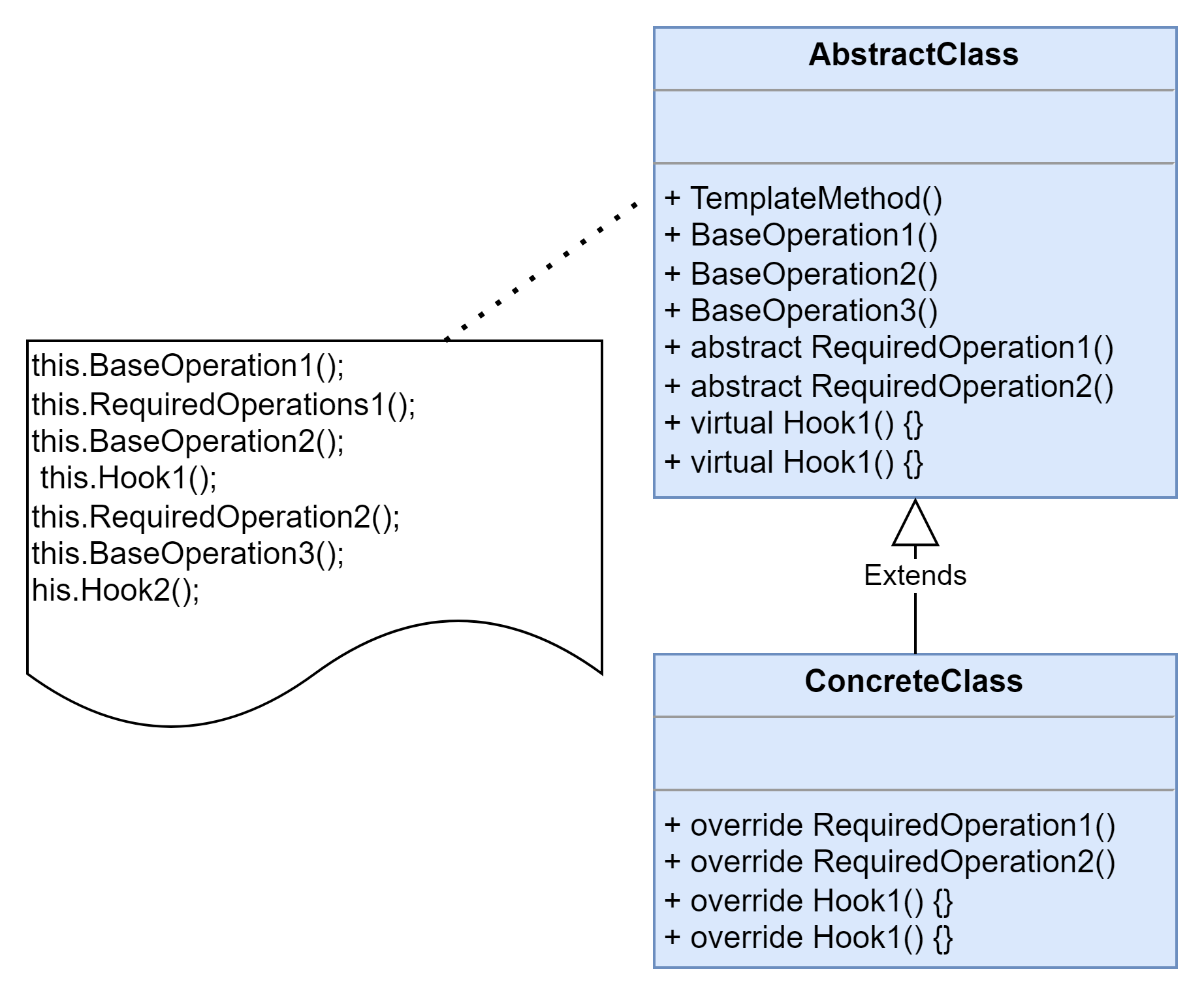模板方法模式 (Template Method Pattern)
定义一个操作中算法的框架,而将一些步骤延迟到子类中。模板方法模式使得子类可以不改变一个算法的结构即可重定义该算法的某些特定步骤。模板方法模式是一种基于继承的代码复用技术,它是一种类行为型模式。
结构图
- AbstractClass(抽象类):在抽象类中定义了一系列基本操作(Operations),这些基本操作可以是具体的,也可以是抽象的,每一个基本操作对应算法的一个步骤,在其子类中可以重定义或实现这些步骤。同时,在抽象类中实现了一个模板方法(Template Method),用于定义一个算法的框架,模板方法不仅可以调用在抽象类中实现的基本方法,也可以调用在抽象类的子类中实现的基本方法,还可以调用其他对象中的方法。
- ConcreteClass(具体子类):它是抽象类的子类,用于实现在父类中声明的抽象基本操作以完成子类特定算法的步骤,也可以覆盖在父类中已经实现的具体基本操作。
- 模板方法
一个模板方法是定义在抽象类中的、把基本操作方法组合在一起形成一个总算法或一个总行为的方法。这个模板方法定义在抽象类中,并由子类不加以修改地完全继承下来。模板方法是一个具体方法,它给出了一个顶层逻辑框架,而逻辑的组成步骤在抽象类中可以是具体方法,也可以是抽象方法。由于模板方法是具体方法,因此模板方法模式中的抽象层只能是抽象类,而不是接口。 - 基本方法
基本方法是实现算法各个步骤的方法,是模板方法的组成部分。基本方法又可以分为三种:抽象方法(Abstract Method)、具体方法(Concrete Method)和钩子方法(Hook Method)。- 抽象方法:一个抽象方法由抽象类声明、由其具体子类实现。在C#语言里一个抽象方法以abstract关键字标识。
- 具体方法:一个具体方法由一个抽象类或具体类声明并实现,其子类可以进行覆盖也可以直接继承。
- 钩子方法:一个钩子方法由一个抽象类或具体类声明并实现,而其子类可能会加以扩展。通常在父类中给出的实现是一个空实现(可使用virtual关键字将其定义为虚函数),并以该空实现作为方法的默认实现,当然钩子方法也可以提供一个非空的默认实现。
示例
using System;
namespace DesignPatterns.TemplateMethod
{
// The Abstract Class defines a template method that contains a skeleton of
// some algorithm, composed of calls to (usually) abstract primitive
// operations.
//
// Concrete subclasses should implement these operations, but leave the
// template method itself intact.
abstract class AbstractClass
{
// The template method defines the skeleton of an algorithm.
public void TemplateMethod()
{
this.BaseOperation1();
this.RequiredOperations1();
this.BaseOperation2();
this.Hook1();
this.RequiredOperation2();
this.BaseOperation3();
this.Hook2();
}
// These operations already have implementations.
protected void BaseOperation1()
{
Console.WriteLine("AbstractClass says: I am doing the bulk of the work");
}
protected void BaseOperation2()
{
Console.WriteLine("AbstractClass says: But I let subclasses override some operations");
}
protected void BaseOperation3()
{
Console.WriteLine("AbstractClass says: But I am doing the bulk of the work anyway");
}
// These operations have to be implemented in subclasses.
protected abstract void RequiredOperations1();
protected abstract void RequiredOperation2();
// These are "hooks." Subclasses may override them, but it's not
// mandatory since the hooks already have default (but empty)
// implementation. Hooks provide additional extension points in some
// crucial places of the algorithm.
protected virtual void Hook1() { }
protected virtual void Hook2() { }
}
// Concrete classes have to implement all abstract operations of the base
// class. They can also override some operations with a default
// implementation.
class ConcreteClass1 : AbstractClass
{
protected override void RequiredOperations1()
{
Console.WriteLine("ConcreteClass1 says: Implemented Operation1");
}
protected override void RequiredOperation2()
{
Console.WriteLine("ConcreteClass1 says: Implemented Operation2");
}
}
// Usually, concrete classes override only a fraction of base class'
// operations.
class ConcreteClass2 : AbstractClass
{
protected override void RequiredOperations1()
{
Console.WriteLine("ConcreteClass2 says: Implemented Operation1");
}
protected override void RequiredOperation2()
{
Console.WriteLine("ConcreteClass2 says: Implemented Operation2");
}
protected override void Hook1()
{
Console.WriteLine("ConcreteClass2 says: Overridden Hook1");
}
}
class Client
{
// The client code calls the template method to execute the algorithm.
// Client code does not have to know the concrete class of an object it
// works with, as long as it works with objects through the interface of
// their base class.
public static void ClientCode(AbstractClass abstractClass)
{
// ...
abstractClass.TemplateMethod();
// ...
}
}
class Program
{
static void Main(string[] args)
{
Console.WriteLine("Same client code can work with different subclasses:");
Client.ClientCode(new ConcreteClass1());
Console.Write("\n");
Console.WriteLine("Same client code can work with different subclasses:");
Client.ClientCode(new ConcreteClass2());
}
}
}运行结果
1
2
3
4
5
6
7
8
9
10
11
12
13
14
Same client code can work with different subclasses:
AbstractClass says: I am doing the bulk of the work
ConcreteClass1 says: Implemented Operation1
AbstractClass says: But I let subclasses override some operations
ConcreteClass1 says: Implemented Operation2
AbstractClass says: But I am doing the bulk of the work anyway
Same client code can work with different subclasses:
AbstractClass says: I am doing the bulk of the work
ConcreteClass2 says: Implemented Operation1
AbstractClass says: But I let subclasses override some operations
ConcreteClass2 says: Overridden Hook1
ConcreteClass2 says: Implemented Operation2
AbstractClass says: But I am doing the bulk of the work anyway
总结
模板方法模式是基于继承的代码复用技术,它体现了面向对象的诸多重要思想,是一种使用较为频繁的模式。模板方法模式广泛应用于框架设计中,以确保通过父类来控制处理流程的逻辑顺序(如框架的初始化,测试流程的设置等)。
优点
- 在父类中形式化地定义一个算法,而由它的子类来实现细节的处理,在子类实现详细的处理算法时并不会改变算法中步骤的执行次序。
- 模板方法模式是一种代码复用技术,它在类库设计中尤为重要,它提取了类库中的公共行为,将公共行为放在父类中,而通过其子类来实现不同的行为,它鼓励我们恰当使用继承来实现代码复用。
- 可实现一种反向控制结构,通过子类覆盖父类的钩子方法来决定某一特定步骤是否需要执行。
- 在模板方法模式中可以通过子类来覆盖父类的基本方法,不同的子类可以提供基本方法的不同实现,更换和增加新的子类很方便,符合单一职责原则和开闭原则。
缺点
需要为每一个基本方法的不同实现提供一个子类,如果父类中可变的基本方法太多,将会导致类的个数增加,系统更加庞大,设计也更加抽象,此时,可结合桥接模式来进行设计。
适用场景
- 对一些复杂的算法进行分割,将其算法中固定不变的部分设计为模板方法和父类具体方法,而一些可以改变的细节由其子类来实现。即:一次性实现一个算法的不变部分,并将可变的行为留给子类来实现。
- 各子类中公共的行为应被提取出来并集中到一个公共父类中以避免代码重复。
- 需要通过子类来决定父类算法中某个步骤是否执行,实现子类对父类的反向控制。
This post is licensed under CC BY 4.0 by the author.
